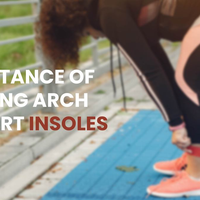Difference Between Orthotic Insoles and Normal Insoles

In the realm of foot health, the battle of insoles rages on - normal insoles versus orthotic insoles. But what sets them apart? Are they just different wordings for the same thing, or is there a significant disparity in function and benefit? Let’s dive in and uncover the mystery behind the disparity.
What are Insoles?
Insoles, also known as shoe inserts or footbeds, are supportive additions placed inside shoes to provide cushioning, support, and comfort for the feet. They come in various shapes, sizes, and materials to cater to different foot types and conditions.
Importance of Insoles for Foot Health
The feet bear the weight of the entire body and endure considerable pressure with every step. Insoles play a crucial role in alleviating discomfort, preventing foot problems, and maintaining overall foot health.
Normal Insoles
Normal insoles, often referred to as generic or cushioned insoles, are mass-produced inserts commonly found in shoes at retail stores. They offer basic cushioning and minimal arch support.
Materials Used in Normal Insoles
Normal insoles are typically made from materials like foam, gel, or silicone. While these materials provide some level of comfort, they lack the specialized support required for addressing specific foot issues.
Benefits of Normal Insoles
Normal insoles are affordable and readily available, making them a convenient option for individuals seeking a slight boost in comfort for everyday activities. However, they may not provide adequate support for those with underlying foot conditions.
Orthotic Insoles
Orthotic insoles, on the other hand, are custom-designed inserts crafted to address individual foot biomechanics and conditions. They are prescribed by healthcare professionals and tailored to meet the unique needs of each patient.
Materials Used in Orthotic Insoles
Orthotic insoles are constructed from high-quality materials such as molded plastics, carbon fiber, or cushioning foams. These materials are chosen for their durability and ability to provide targeted support and correction.
Benefits of Orthotic Insoles
Orthotic insoles offer superior support and alignment for the feet, helping to alleviate pain and improve overall foot function. They are particularly beneficial for individuals with conditions like flat feet, plantar fasciitis, or overpronation.
Differences Between Orthotic insoles and Normal Insoles
Support and Alignment
While normal insoles offer basic cushioning, orthotic insoles are designed to provide customized support and alignment, addressing specific biomechanical issues.
Customization Options
Normal insoles are mass-produced and come in standard sizes, offering limited customization. In contrast, orthotic insoles are personalized to fit the unique shape and needs of each individual's feet.
Medical Conditions Addressed
Orthotic insoles are recommended for individuals with various foot conditions, including plantar fasciitis, bunions, arthritis, and diabetic foot problems. Normal insoles may provide temporary relief but are not specifically designed to address underlying medical issues.
Price Range
Normal insoles are generally more affordable than orthotic insoles due to their mass-produced nature. However, the cost of orthotic insoles is justified by their custom design and ability to provide long-term relief for chronic foot problems.
Choosing the Right Insoles
Foot Type and Arch Support
When selecting insoles, consider your foot type and arch support needs. Orthotic insoles are ideal for individuals with high arches, flat feet, or other biomechanical abnormalities that require specialized support.
Activity Level
Your activity level and the type of footwear you use also influence your choice of insoles. If you lead an active lifestyle or participate in high-impact sports, orthotic insoles can provide the necessary support and cushioning to prevent injuries.
Existing Foot Conditions
If you have existing foot conditions or are experiencing chronic foot pain, consult with a healthcare professional to determine whether orthotic insoles are suitable for your needs. They can assess your foot biomechanics and recommend the appropriate course of action.
Conclusion
Insoles may seem like a minor accessory, but they play a significant role in supporting and protecting our feet. While normal insoles offer basic comfort, orthotic insoles take it a step further by providing personalized support and addressing specific foot issues. Whether you're seeking relief from pain or aiming to prevent future problems, choosing the right insoles can make all the difference in your foot health journey.
FAQs
What are orthotic insoles made of?
- Orthotic insoles are typically made from high-quality materials such as molded plastics, carbon fiber, or cushioning foams.
Can I use orthotic insoles in any shoe?
- Yes, orthotic insoles can be used in most shoes, including sneakers, dress shoes, and boots. However, it's essential to ensure that the shoe has enough room to accommodate the additional bulk of the insole.
Do I need a prescription for orthotic insoles?
- Yes, orthotic insoles are prescribed by healthcare professionals such as podiatrists or orthopedic specialists. They assess your foot biomechanics and recommend the appropriate type of insole based on your individual needs.
How often should I replace my insoles?
- Insoles should be replaced every six to twelve months, depending on usage and wear. If you notice signs of deterioration or decreased support, it's time to invest in a new pair of insoles.
Are orthotic insoles covered by insurance?
- In some cases, orthotic insoles may be covered by health insurance plans, especially if they are prescribed to treat a specific medical condition. It's best to check with your insurance provider to determine your coverage options.




